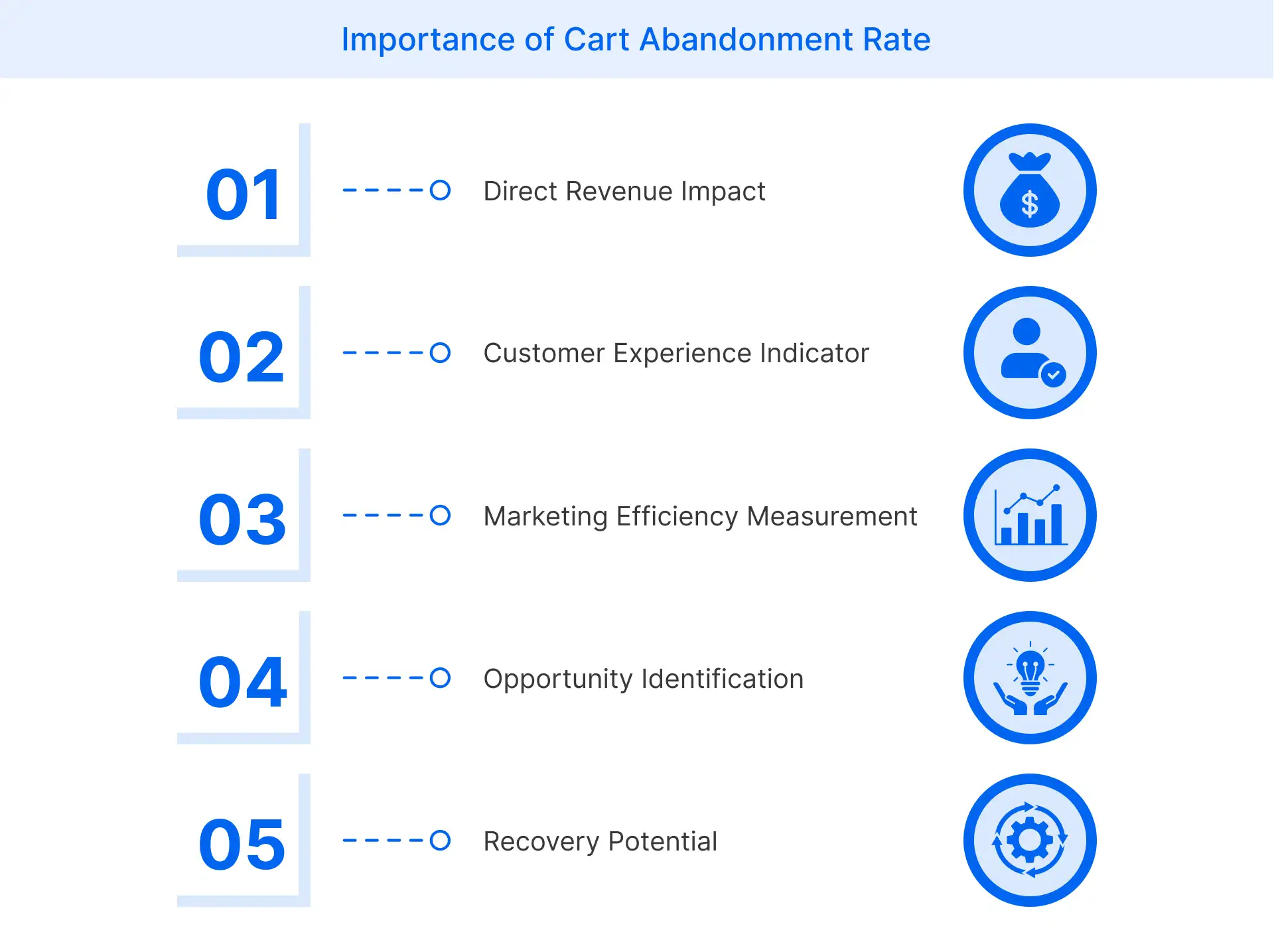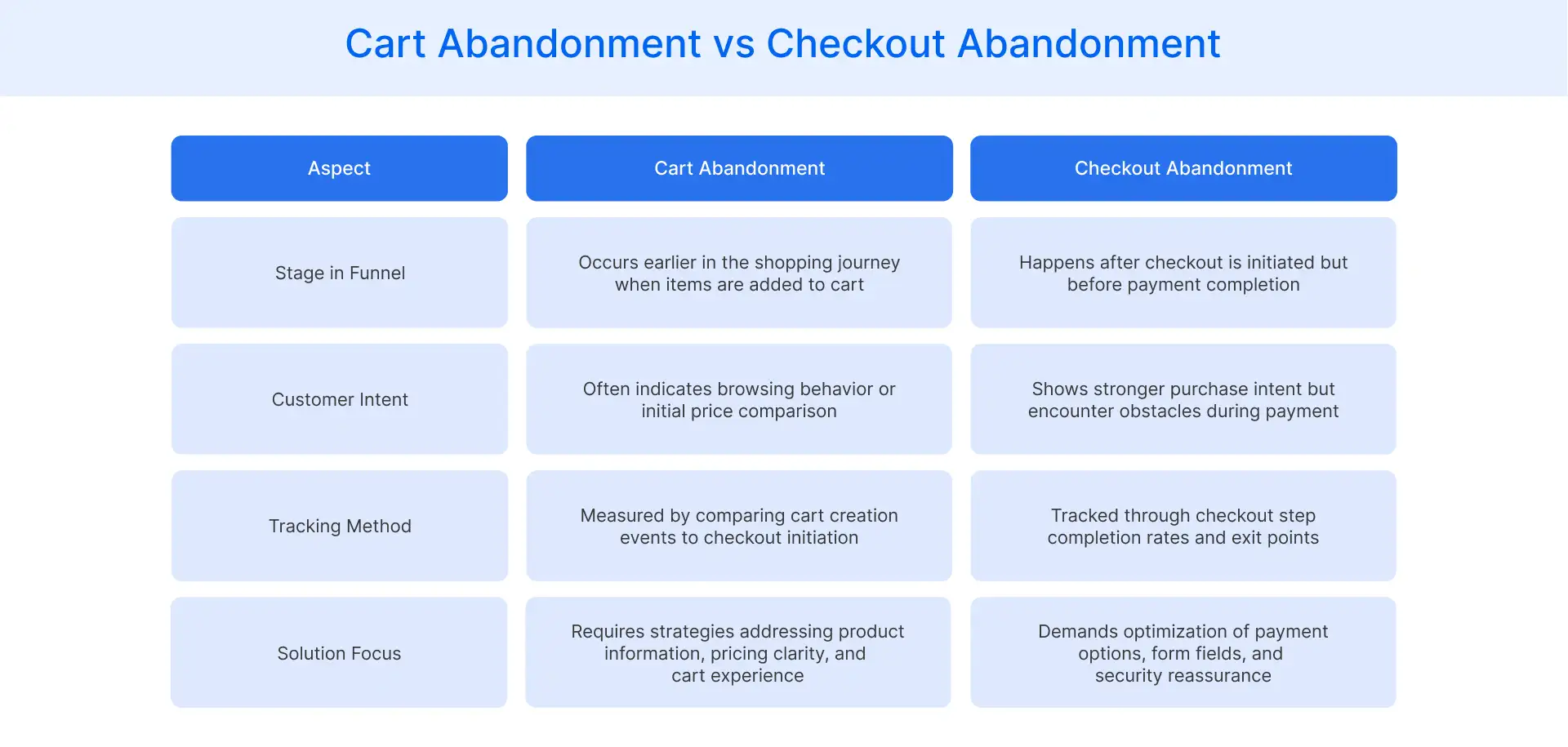Table of Contents
- What is Cart Abandonment Rate?
- Why is Shopping Cart Abandonment Rate an Important Concern for Retailers?
- What is the Average Shopping Cart Abandonment Rate?
- What Are the Common Reasons for Shopping Cart Abandonment?
- How Do Cart Abandonment and Checkout Abandonment Differ?
- How to Reduce the Cart Abandonment Rate?
- Conclusion
What is Cart Abandonment Rate?
Cart abandonment rate represents the percentage of online shoppers who initiate a purchase by adding items to their cart page but fail to complete transactions. You can view this metric as a critical indicator of your conversion funnel’s health, highlighting where potential buyers disengage from their buying journey.
This measurement provides a window into customer behavior, revealing hesitation points that prevent shoppers from making a purchase. By tracking your cart abandonment rate, you gain valuable insights into various aspects of your online shopping experience, including pricing transparency, checkout flow, payment options, and overall site performance.
Why is Shopping Cart Abandonment Rate an Important Concern for Retailers?
Monitoring the online shopping cart abandonment rate enables retailers to identify revenue loss points, enhance the shopping experience, and improve their overall e-commerce performance.
- Direct Revenue Impact: Each abandoned cart represents potential sales that you have already invested in acquiring through marketing efforts but failed to convert into actual revenue.
- Customer Experience Indicator: High cart abandonment rates signal friction points in your shopping experience that frustrate potential customers and may drive them to competitors.
- Marketing Efficiency Measurement: The cart abandonment rate helps you assess the effectiveness of your acquisition strategies and whether you are attracting qualified traffic with genuine purchase intent.
- Opportunity Identification: By analyzing patterns in abandoned carts, you can identify specific products, price points, or customer segments that encounter conversion obstacles.
- Recovery Potential: Understanding your online cart abandonment rate creates opportunities to implement targeted recovery strategies that can recapture otherwise lost sales and boost overall conversion rates.

How to Calculate Shopping Cart Abandonment Rate?
To calculate the cart abandonment rate, you must use the following formula:
Cart Abandonment Rate = (Number of Abandoned Carts ÷ Total Number of Carts Created) × 100
Alternatively, you can use this equivalent formula:
Cart Abandonment Rate = [1 – (Number of Completed Purchases ÷ Number of Shopping Carts Created)] × 100
For example, if your online store records 500 shopping carts created in a week but only 150 completed purchases, your abandonment rate calculation would be:
[1 – (150 ÷ 500)] × 100 = 70%
This means 70% of shoppers who initiated purchases left without completing them, which directly impacts your average order value and revenue potential.
What is the Average Shopping Cart Abandonment Rate?
Benchmarking cart abandonment rates against industry standards helps retailers evaluate their ecommerce stores' performance and identify improvement opportunities. Research from Baymard Institute indicates the global average cart abandonment rate hovers around 70%.
- Retail & E-commerce: General retail businesses face an average cart abandonment rate between 70-75%, requiring strategic optimization of the checkout experience.
- Travel & Airlines: Travel industry websites encounter remarkably high abandonment rates of 85-90%, largely due to research-intensive buying behaviors and comparison shopping.
- Fashion & Apparel: Fashion retailers experience cart abandonment rates averaging 75%, influenced by sizing concerns and visual presentation challenges on product pages.
- Luxury Goods: High-end product sellers witness approximately 80% abandonment rates, as customers typically conduct extensive research before committing to premium purchases.
- Electronics: Technology retailers see slightly lower abandonment rates between 68-72%, though technical specifications and compatibility questions can still create friction.
- Financial Services: Banking and financial products face the challenge of 83% abandonment rates, reflecting the complex decision-making involved in financial commitments.
Understanding these cart abandonment statistics allows online retailers to set realistic improvement goals and prioritize optimization efforts where they will have the greatest impact on conversion rates.
What Are the Common Reasons for Shopping Cart Abandonment?
Understanding why customers abandon their carts allows you to address specific pain points in your purchase journey and implement targeted solutions to increase your conversion rates.
- Unexpected Additional Costs: Shoppers frequently abandon their carts when confronted with surprise shipping fees, taxes, or other charges revealed only during checkout.
- Complex Checkout Process: Your customers will likely abandon their purchase if they encounter a lengthy, multi-step checkout that demands excessive information or creates confusion.
- Required Account Creation: Forcing shoppers to create an account before completing their purchase adds unnecessary friction that drives away potential one-time or first-time buyers.
- Payment Security Concerns: Customers abandon carts when they perceive security risks or don’t see familiar trust indicators during your payment process.
- Limited Payment Options: Your cart abandonment rate increases when customers can’t find their preferred payment method among your available options at checkout.
How Do Cart Abandonment and Checkout Abandonment Differ?
While often used interchangeably, cart abandonment and checkout abandonment represent distinct phenomena in the e-commerce conversion funnel.
Cart abandonment encompasses all instances where shoppers add items to their cart but leave the site without initiating checkout. Checkout abandonment specifically refers to customers who begin the checkout process but exit before completing payment. Both metrics reveal different customer pain points requiring targeted solutions.

How to Reduce the Cart Abandonment Rate?
Ecommerce businesses can implement strategic improvements to their shopping experience to significantly reduce cart abandonment rates and capture otherwise lost revenue.
- Streamline Your Checkout Process: Offer guest checkout options without requiring mandatory account creation, as many shoppers prefer a quick and seamless process. Minimize form fields and implement auto-save features to prevent customers from losing progress if they leave and return later.
- Increase Transparency and Trust: Display all costs upfront, including shipping, taxes, and other fees. Offer multiple payment options, including credit cards, digital wallets, and PayPal. Add trust signals, such as security badges and customer reviews, to build confidence.
- Enhance the User Experience: Ensure your website is mobile-friendly with a seamless experience across devices. Optimize page load times to prevent frustration. Offer live chat support to answer questions in real-time and include clear progress indicators.
- Implement Abandoned Cart Recovery: Send timely, personalized cart abandonment emails reminding customers about items in their abandoned carts, potentially with incentives. Run retargeting campaigns showing ads with abandoned items. Use exit-intent popups when users are about to leave your site.
- Analyze and Continuously Optimize: Track abandonment metrics to identify drop-off points and understand why customers abandon carts. Conduct A/B testing to optimize different elements of your checkout process and recovery strategies. Segment customers based on behavior for personalized messaging.
Conclusion
The cart abandonment rate is a critical e-commerce metric that reflects buyer hesitation and friction in the purchase journey. Tracking and analyzing this rate helps you identify weak points in the checkout process and take corrective action.
By simplifying forms, offering transparent pricing, expanding payment options, and using recovery tactics like retargeting and abandoned cart emails, you can reduce abandonment and improve conversions.
A well-optimized checkout experience not only boosts revenue but also builds trust and long-term customer loyalty. Prioritizing this area can significantly strengthen your online retail performance and maximize the value of your traffic.
FAQ
Mobile users abandon carts more frequently than desktop shoppers due to smaller screens and complex checkout forms. Thumb-friendly design, simplified forms, and digital wallet integration create a frictionless mobile purchase experience that reduces abandonment.
Cart abandonment rates fluctuate throughout the year. Black Friday and Cyber Monday typically show lower abandonment rates, while browsing-heavy periods show increases. Ecommerce sites should prepare recovery strategies for post-holiday peaks when comparison shopping intensifies.
Retargeting campaigns reconnect with the target audience by displaying personalized ads featuring selected products across other websites and social media. This visual reminder helps shoppers recall unfinished purchases, thereby increasing overall recovery rates.
Site speed directly impacts cart abandonment rates. Customers expect pages to load quickly and will abandon slow-loading checkout processes. Optimizing image sizes, leveraging browser caching, and implementing content delivery networks improve performance.

